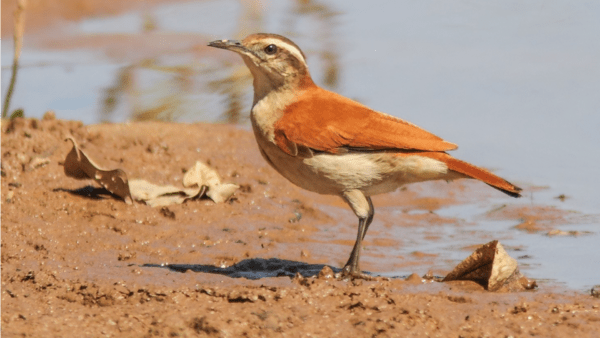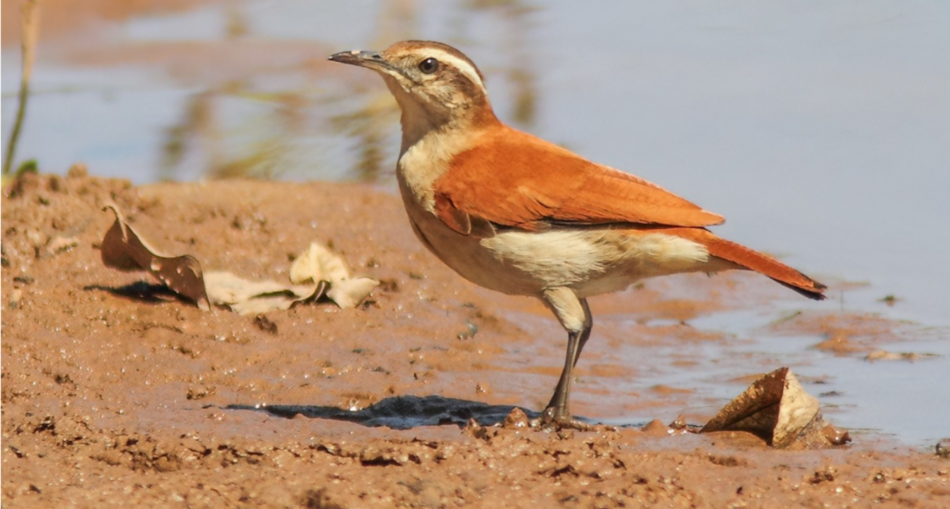The Pale-legged Hornero (Furnarius leucopus) is a fascinating bird species commonly found across Guyana’s lowlands. Known for its dome-shaped mud nests and distinctive appearance, this bird plays an essential role in the country’s vibrant birdlife.

The Pale-legged Hornero [Photo: William Price]
IDENTIFICATION AND CHARACTERISTICS
The Pale-legged Hornero is a medium-sized bird, typically measuring 15 to 18 cm (5.9 to 7.1 inches) in length and weighing about 37 to 49 grams (1.3 to 1.7 ounces).
It is often identified by its pale legs, reddish-brown eyes, and rufous-brown plumage.
The bird’s upper body is rich in a warm, orange-brown colour, while its throat and belly are lighter, often pale tan or white.
One of the most distinctive features is its loud, descending series of chip notes, which can often be heard as the bird sings from high perches.
HABITAT AND DISTRIBUTION IN GUYANA
The Pale-legged Hornero is frequently found near water sources such as rivers, marshlands, and open woodlands along Guyana’s lush landscape.
Its preference for humid, riverside areas makes it a common sight in southwestern Guyana.
The bird also adapts well to semi-urban areas and is often seen near human settlements, roadsides, and parks.
Though the Pale-legged Hornero is primarily associated with forest edges and agricultural lands, it thrives in lowland habitats below 1,100 meters (3,600 feet) in elevation.
This adaptability allows it to flourish in various ecosystems throughout the country, adding to its resilience and growing population.
NESTING HABITS AND BREEDING
One of the most intriguing aspects of the Pale-legged Hornero is its mud-built nest, which resembles a small oven.
This sturdy nest is constructed from mud and animal dung, providing a safe chamber where the bird can lay its eggs. Both male and female birds work together to build the nest, typically found on tree branches or horizontal structures like utility poles. The nest is often lined with dry plant material to create a comfortable environment for raising their chicks.
While the exact details of its breeding season in Guyana are not well documented, observations from other regions suggest a breeding period that can last up to 33 days.
The Hornero’s nestlings are fed and cared for by both parents until they are ready to fledge.
FEEDING BEHAVIOUR
The Pale-legged Hornero’s diet consists mainly of arthropods and small invertebrates, including insects, snails, and occasionally even small amphibians.
They are often seen foraging on the ground, confidently strutting as they turn over leaves in search of food. Their feeding behaviour is both methodical and efficient, helping to control pest populations in their habitats.
VOCALISATIONS
The Pale-legged Hornero is a vocal species, with its song being one of the most recognisable sounds in the bird community of Guyana.
The bird’s call is characterised by a long series of loud, staccato notes that gradually descend in pitch. This distinct song, along with its scratchy and reedy calls, makes it easy to identify even before it is seen.
IMPORTANCE IN GUYANA’S BIODIVERSITY
As a bird species that adapts well to both natural and human-altered environments, the Pale-legged Hornero plays an essential role in Guyana’s biodiversity.
Its presence around rivers and near human settlements helps maintain ecological balance, as the bird controls insect populations and contributes to the dispersal of plant materials through its nesting habits.
Moreover, the Pale-legged Hornero benefits from moderate habitat alteration and deforestation, expanding its range into previously forested areas that have been cleared for agriculture or development.
This adaptability ensures that it remains a common species in the region, even as landscapes change.
CONSERVATION STATUS
The International Union for Conservation of Nature (IUCN) has listed the Pale-legged Hornero as a species of Least Concern.
This status is due to its wide distribution across South America and its increasing population, thanks to its ability to thrive in both natural and modified environments.
While no significant threats have been identified for this species in Guyana, its protection and the conservation of its habitat remain vital to maintaining its population.
References
- https://en.wikipedia.org/wiki/Pale-legged_hornero
- https://ebird.org/species/palhor3
- https://birdsoftheworld.org/bow/species/palhor3/cur/introduction







